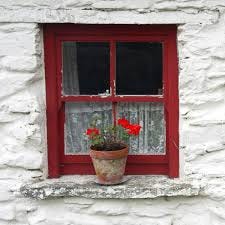Lace Curtain vs. Shanty Irish
On being too poor to have a pot to piss in or a window to throw it out of.
My grandma’s people came from the West of Ireland, but there was a huge distinction between the families of her two grandparents. From this came two sayings, and one Irish word, all which have been adopted by Americans. (Welcome to Slua, a Substack which examines how the Irish language has impacted American English, as exemplified by my dear, departed Grandmother.)
Grandma’s grandfather was brought over from County Mayo by his family during the height of the potato famine. Michael Haran was born in 1848 in an area of North Mayo amid the Ox Mountains where arable land was dotted between areas of bog and rock. The potato was a mainstay of his family and thousands of others because it could easily be grown in rocky soil, and it provided the daily sustenance necessary for survival. When a potato mold began spreading in 1845, especially in Western and Southern Ireland, the entire crop was eventually destroyed. During the Famine which ensued, known as An Gorta Mor or the Great Hunger, over 1 million Irish died from starvation and disease, and another 1.3 million emigrated, with over 700,000 coming to the United States. Those emigres, who spoke Irish, were ill-educated, and were overwhelmingly Roman Catholic, settled in places where they could work on the railroads and the canals which were being built. They were generally referred to as “Shanty” Irish, because they were poor and lived in a seantán, pronounced “shan-taw,” the Irish word for a shack or hovel.
A seantán would have been constructed of crushed sea-shells or stone, and whitewashed, if possible. The roof would have been made from thatch. There would have been no windows, primarily because one wished to keep the damp outside, but also due to the cost of a window. Inside, cooking would be done over a fire, and animals would have been keep in an adjoining room. The floors would have been dirt or stone, and the water would have been obtained from a nearby stream or well. An outhouse, or privy of some sort, would have been outside. There may have been a chamber pot kept under a bed for urinating at night which would have been emptied the next day.
After settling in the mountains of western Maryland, to work on the B & O Railroad, Mr. Haran married a woman who was “Lace Curtain” Irish. The family of Mary “Bridget” Higgins had come from a little town in Donegal, where they lived in an actual house with real windows, much like those described in Peader O’Donnell’s famous novel, The Big Windows. Lace, a skill still prized in Ireland, would have been used to create lace curtains for the windows. While a larger number of Irish emigrated to the U.S. because of the Famine, many had been coming over before that due to religious discrimination and economic hardship. “Lace-curtain” Irish thus described those who had a modicum of income, or, as my Grandmother would say, would have fruit in the house even when no one was sick.
The Shanty Irish, on the other hand, were those of whom she said, “They are so poor, they don’t have a pot to piss in or a window to throw it out of.”
Here’s to windows, and lace curtains, and having a pot to piss in.
Until next time, thanks Grandma.



